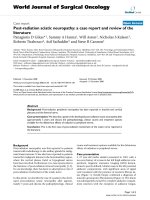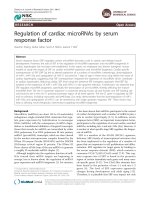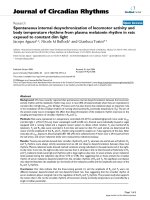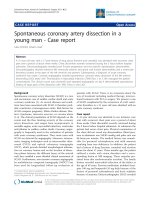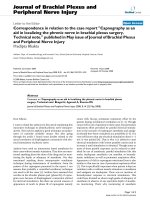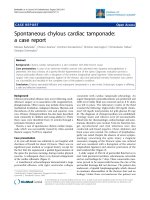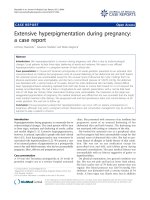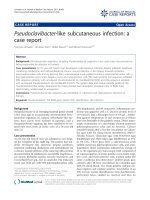Báo cáo y học: "Spontaneous chylous cardiac tamponade: a case report" pptx
Bạn đang xem bản rút gọn của tài liệu. Xem và tải ngay bản đầy đủ của tài liệu tại đây (596.09 KB, 4 trang )
CAS E REP O R T Open Access
Spontaneous chylous cardiac tamponade:
a case report
Nikolaos Barbetakis
1*
, Christos Asteriou
1
, Dimitrios Konstantinou
2
, Dimitrios Giannoglou
2
, Christodoulos Tsilikas
1
,
Georgios Giannoglou
2
Abstract
Background: Chylous cardiac tamponade is a rare condition with little known cause.
Case presentation: A case of an otherwise healthy woman who admitted with dyspnea and palpitations is
presented. She had a history of a painful flexion-hyperextension of the spine. Diagnostic evaluation proved a
chylous pericardial effusion with a disruption of the anterior longitudinal spinal ligament. Video-assisted thoracic
surgery with mass supradiaphragmatic ligation of the thoracic duct and pericardial window formation was carried
out successfully and resulted in the complete cure of the patient’s condition.
Conclusion: Chylous pericardial effusion and subsequent tamponade is a rare entity. Endoscopic surgery is offering
a safe and effective treatment.
Background
Chylous pericardial effusion may occur following cardi-
othoracic surgery or in association with congenital lym-
phangiomatosis. Other causes may include chest trauma,
mediastinal irradiation, malignant diseases, filariasis and
thrombosis of the subclavian vein and superior vena
cava. Primary chylopericardium has also been described,
most commonly in children and young adults [1]. Thirty
three cases were identified from 31 articles through a
systematic literature search.
Herein, a case of spontaneous chylo us cardiac tampo-
nade which was successfully treated by video-assisted
thoracic surgery (VATS) is reported.
Case presentation
A 41-year-old female was admitted to our hospital with
shortness of breath for about 24 hours. There was no
significant past medical or surgical history except for
the fact that she experienced a painful hyperextension of
the spine the previous morning, during routine physical
exerci se. A subsequent chest x-ray showed enlargement
of the cardiac silhouette (Figure 1).
A transthoracic echocardiogram demonstrated a large
pericardial effusion, with right ventricular collapse
consistent with cardiac tamponade physiology. An
urgent therapeutic pericardiocentesis was performed and
1200 ml of milky fluid was removed and an 8 Fr drain
was left in place. The laboratory results of the fluid
revealed the following: triglycerides 550 mg/dl, choles-
terol 110 mg/dl, total proteins 4.6 g/dl, glucose 85 mg/
dl. The diagnosis of chylopericardium was established.
Cytology stains and cultures were all unremarkable.
Blood tests for rheumatologic, endocrinologic and auto-
immune disorders were normal. Tests for ba cteri al, fun-
gal, mycobacterial and viral infections were also
conducted and found negative. Chest, abdomen and
brain scans were normal. No evidence of lympha deno-
pathy was noted. Despite the abse nce of sever e sympto-
matology concerning the spine injury a magnetic
resonance imaging of th e thoracic spine was ordered
and was consistent with a disruption of the anterior
longitudinal ligament and anterior protrusion of the
intervertebral disc (Figure 2).
A daily output of 350 ml of pericardial fluid led us to
start t otal parenteral nutrition, subcutaneous octreotide
and no oral feedings for 7 days. These conservative mea-
sures p roved to be unsuccessful because the rate of the
pericardial drainage did not decrease. The patient also
underwent, a bipedal lymphangiography which showed
no anatomic abnormalities of the thoracic duct and no
leakage. Under these circumstances the patient was
* Correspondence:
1
Cardiothoracic Surgery Department, Theagenio Cancer Hospital, Al.
Symeonidi 2, Thessaloniki, Greece, 54007
Barbetakis et al. Journal of Cardiothoracic Surgery 2010, 5:11
/>© 2010 Barbetakis et al; licensee BioMed Central Ltd. This is an Open Access article distributed under the terms of the Creative
Commons Attribu tion License ( which permits unrestricted use, distribution, and
reproduction in any medium, provided the original work is properly cited.
addressed for thoracic surgical ev aluation. The patient
finally underwent a video-assisted supradiaphragmatic
mass ligation of the thoracic duct and creation of a
pleuropericardial window through a low right mini thor-
acotomy. Ligation of the thoracic duct together with all
the adjacent soft tissue between the esophagus, the azy-
gos vein and the aorta was performed. The patient was
recover ed uneventfully for both spine injury and tampo-
nade. There has been no recurrence of the pericardial
effusion for 12 months.
Discussion
Chylopericardium is sometimes a consequence of thor-
acic and cardiac surgery. It may also occur as a result of
ches t trauma, mediastinal neoplasms, mediastinal tuber-
culosis, mediastinal radiotherapy, and thromb osis of the
subclavian vein [2].
Idiopathic chylopericardium is a rare entity. It was
first reported in 1886 by Hasebrock. The term primary
isolated chylopericardium was first reported by Groves
and Effler in 1954 [3].
Its precise etiology still remains unknown. Primary
chylous pericardial effusions result from retrograde flow
through abnormal lymphatics into rich pericardial
plexus. Such abnorm al lymphatic channels may repre-
sent lymphangiomas or they may be a part of larger
lymphatic tumors [4]. Severa l mechanisms have been
proposed to explain the development of chylous pericar-
dial effusions. Most secondary effusions are caused by
interruption of the thoracic duct by surgery, inflamma-
tion or non lymphatic tumor. Normal lymphatic valves
prevent chylous reflux into the pericardial plexus even
after ligation of the thoracic duct proximal to the peri-
cardial tributaries, unless concurrent superior vena caval
ligation prevents collateral flow. Blunt chest trauma may
rupture lymphatic valves by precip itously elevati ng
intrathoracic pressure [5]. This mechanism caused b y
the flexion - hyperextension movement of the thoracic
spine, could be the underlying mechanism in this case.
The problem is that pedal lymphoscintigraphy did not
prove any communication between thoracic duct or
branches and pericardial sac.
Figure 1 Preoperative chest x-ray demonstrating cardiac enlargement due to pericardial effusion.
Barbetakis et al. Journal of Cardiothoracic Surgery 2010, 5:11
/>Page 2 of 4
Symptoms depend on the importance o f the effusion
and on compression of the cardiac cavities. Chronic
effusions may remain asymptomat ic for a long time.
Whenever cardiac compression occurs symptoms are
those observed with tamponade and include: exertional
dyspnea, chest pain, fatigue and palpitations. Asympto-
matic pericardial effusions are usually diagnosed on rou-
tine chest x-ray, echocardiography, computerized
tomography scan or magnetic resonance imaging.
Chylopericardium is usually diagnosed by pericardio-
centesis that shows the presence of chylous fluid with
high triglyceride level. Pathological analysis demon-
strates white-yellow chylous fluid with numerous foamy
cells and fat globules shown by Sudan III staining [6].
Also noted are extra-cellular fat droplets and predomi-
nance of lymphocytes [7].
Many diagnostic modalities have been described,
including ob servation of Sudan III dye d istributio n into
the pericardial cavity after oral intake of Sudan III dye,
lymphangioscintigraphy, lymphangiography and e valua-
tion of chest radioactivity after an oral dose of 131I-trio-
lein. All of these methods are used to ascertain the
cause of the chylous pericardial effusion [8]. According
to the literature, demonstrable abnormalities of thoracic
lymphatic vessels were present in 4 out of 5 patients
who presented with cardiac tamponade and in 1 of 2
patients who developed tampo nade after pericardiocent-
esis [4].
Non surgical management includes dietary regimen
with nothing per os or medium cha in triglycerides, total
parenteral nutrition and subcutaneous octreotide. How-
ever this conservative treatment alone is associated with
reaccumulation of fluid [9].
Surgical treatment has been proposed to halt recur-
rence and progression for cardiac tamponade. Surgical
modalities include pericardial window formation, thor-
acic duct ligation and peri cardial-peritoneal shunting.
The success of combined thoracic duct ligation above
the diaphragm and peric ardial window has been docu-
mented [9]. Furrer and collea gues described the first
successful thoracoscop ic approach to primary chyloperi-
cardium [1]. The authors mentioned a mass ligation of
all tissues situated betwe en the azygos vein, vertebral
body and descending aorta. This kind of approach was
used in our case with e xcellent results. The left-sided
approach has some disadvantages because in the lower
thoracic cavity, the thoracic duct is located to the right
of the descending aorta. This prevents easy access to the
duct when entering from the left hemithorax. The
VATS procedure is being used increasingly and is asso -
ciated with less postoperative pain and pulmonary dys-
function [10].
Conclusions
In conclusio n, a rare case of chylous cardiac tamponade
probablyrelatedtoapreviousthoracicspineflexion-
hyperextension injury was presented. Lymphoscintigra-
phy failed to prove communication between thoracic
duct and pericardial sac. Video-assisted thoracic surgery
with pericardial window formation and supradiaphrag-
matic mass ligation of the thoracic duct was curative.
Consent
Written informed consent was obtained from the patient
for publication of this case report and accompanying
images. A copy of the written consent is available for
review by the Editor-in-Chief of this journal.
Figure 2 Magnetic resonance imaging was consistent with a
disruption of the anterior longitudinal ligament and anterior
protrusion of the intervertebral disc (black arrow).
Barbetakis et al. Journal of Cardiothoracic Surgery 2010, 5:11
/>Page 3 of 4
Author details
1
Cardiothoracic Surgery Department, Theagenio Cancer Hospital, Al.
Symeonidi 2, Thessaloniki, Greece, 54007.
2
Cardiology Department, Aristotle
University, AHEPA Hospital, S. Kiriakidi 1, Thessaloniki, Greece, 54630.
Authors’ contributions
NB, CA, DK, DG and CT took part in the care of the patient and contributed
equally in carrying out the medical literature search and preparation of the
manuscript. GG participated in the care of the patient and had the
supervision of this report. All authors approved the final manuscript.
Competing interests
The authors declare that they have no competing interests.
Received: 26 December 2009 Accepted: 17 March 2010
Published: 17 March 2010
References
1. Furrer M, Hopf M, Ris HB: Isolated primary chylopericardium: treatment
by thoracoscopic thoracic duct ligation and pericardial fenestration. J
Thorac Cardiovasc Surg 1996, 112:1120-1121.
2. Mehrotra S, Peeran NA, Bandyopadhyay A: Idiopathic chylopericardium.
An unusual cause of cardiac tamponade. Tex Heart Inst J 2006, 33:249-252.
3. Groves LK, Effler DB: Primary chylopericardium. N Engl J Med 1954,
250:520-523.
4. Dunn RP: Primary chylopericardium: a review of the literature and an
illustrated case. Am Heart J 1975, 89:369-377.
5. Gallant TE, Hunziker RJ, Gibson TC: Primary chylopericardium: The role of
lymphangiography. Am J Roentgenol 1977, 129:1043-1045.
6. Wang CH, Yen TC, Ng KK, Lee CM, Hung MJ, Cherng WJ: Pedal (99m) Tc-
sulfur colloid lymphoscintigraphy in primary isolated pericardium. Chest
2000, 117:598-601.
7. Akamatsu H, Amano J, Sakamato T, Suzuki A: Primary chylopericardium.
Ann Thorac Surg 1994, 58:262-266.
8. Dib C, Tajik AJ, Park S, Kheir ME, Khanderia B, Mookadam F:
Chylopericardium in adults: a literature review over the past decade
(1996-2006). J Thorac Cardiovasc Surg 2008, 136:650-656.
9. Sakata S, Yoshida I, Otani Y, Ishikawa S, Morishita Y: Thoracoscopic
treatment of primary chylopericardium. Ann Thorac Surg 2000,
69:1581-1582.
10. Kirby TJ, Mack MJ, Landreneau RJ, Rice TW: Lobectomy–video assisted
thoracic surgery versus muscle-sparing thoracotomy. A randomized trial.
J Thorac Cardiovasc Surg 1995, 109:997-1001.
doi:10.1186/1749-8090-5-11
Cite this article as: Barbetakis et al.: Spontaneous chylous cardiac
tamponade: a case report. Journal of Cardiothoracic Surgery 2010 5:11.
Submit your next manuscript to BioMed Central
and take full advantage of:
• Convenient online submission
• Thorough peer review
• No space constraints or color figure charges
• Immediate publication on acceptance
• Inclusion in PubMed, CAS, Scopus and Google Scholar
• Research which is freely available for redistribution
Submit your manuscript at
www.biomedcentral.com/submit
Barbetakis et al. Journal of Cardiothoracic Surgery 2010, 5:11
/>Page 4 of 4

